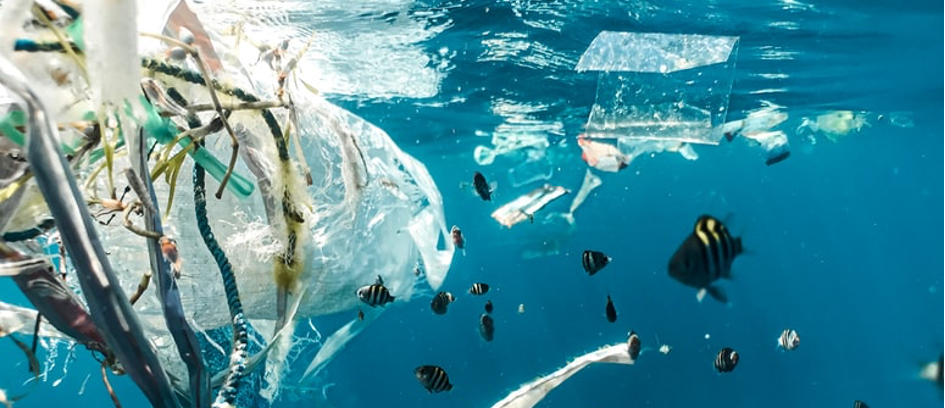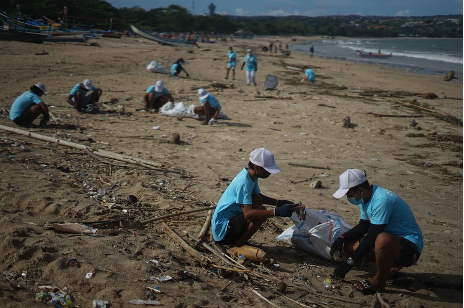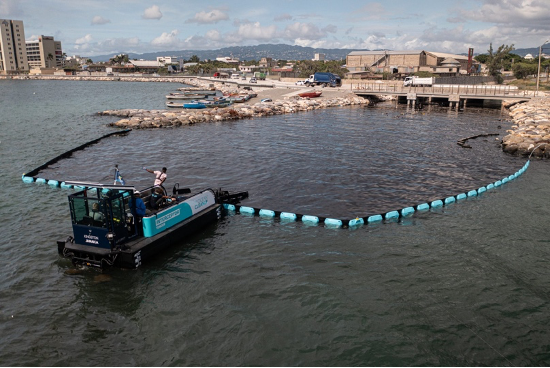The plastic trash clash
From plastic pollution to revolution
By Jeanette Morren, 4 april 2022
The first week of March was a historical one: aimed to end plastic pollution, representatives from 175 countries agreed to forge a legally-binding treaty before the end of 2024. This was discussed at the UN Environmental Assembly in Nairobi. The head of this assembly even called the treaty the “biggest global environmental deal” since the 2015 Paris climate agreement. The treaty will include plans to tackle plastic pollution at all stages possible: from production, to consumption and disposal. One of the intents is to reduce plastic pollution in oceans. This goal is shared by The Ocean Cleanup, a Dutch non-profit organization that develops technologies to rid oceans of plastic. After their two first successful technologies, they are piloting a fleet of ten larger systems expected to reduce the plastic soup with 50% every five years.

Every day, The Ocean Cleanup – consisting of 120 engineers, scientists, consultants, volunteers and other staff – works towards their mission: to have removed 90% of floating ocean plastic by 2040. A study in 2014 estimated that more than 5 trillion plastic pieces weighing 226 million kilograms afloat at sea. To have an idea; this is equivalent to 8,250,000,000 empty 500ml bottles. So, a lot. This study the first to compare all sizes of floating plastic in the oceans – ranging from the largest items to small plastic particles. The same author stated that this amount would be around 0.1% of the annual plastic production around that time. A more recent study estimated a number of 5-15 trillion plastic pieces – a large range, but it is difficult to give concrete metrics. Plastic islands in oceans can change rapidly due to large storms and other extreme weather conditions.
The amounts of plastic in our oceans seem like a grain of sand compared to the total production. Furthermore, if we want to tackle plastic pollution, it starts with lowering plastic production, increased recycling and improved waste management. It sounds like removing plastics from the oceans is like fighting a losing a battle. So why is it still important to make this effort?
Even though it does not seem a lot, the amount of plastic that currently floats around in the ocean still causes a lot of issues. You’ve probably seen one before: a picture of the gut content of a whale showing its plastic diet, or of a turtle strangled in plastics. Plastic ingestion happens by accident when animals confuse it for food, or from eating other animals with accumulated plastic in their tissues. In this way, plastic particles travel through entire marine food webs. This can lead to impaired food intake, decreased growth and reproduction, mobility issues and often even death. Besides this, plastic pollution in oceans threatens business activities such as tourism and fishing, and leads to marine biodiversity loss. Coral reefs for example, are declining due to entangled fishing lines, abrasion and suffocation by plastic waste. These ecosystems are extremely important, since they house many underwater species, protect coastal areas from extreme waves, and provide a crucial source of income for many people.
Besides this, litter blocks sunlight under water, which is essential for algae and plankton to survive. These organisms work as plants, and are responsible for the production of more than 50% of the oxygen on Earth. They also consume CO2 from their environment. In this way they lower the concentration of this greenhouse gas in the air, which normally traps heat. Without these tiny organisms, global warming would be at another level.
Single-use plastics – such as shopping bags and PET bottles – are everywhere, and sadly they are among the most polluting materials globally. The United Nations even estimate that if we do not take action now, there will be more plastic in the ocean than fish by 2050. The recognized dangers of marine plastics have pushed several initiatives world-wide to tackle this issue. The Ocean Cleanup was the first to develop a technological solution to the plastic pollution in oceans and gained a lot of media attention over the past years. What started in 2013 as a high school project for Boyan Slat at the age of 18, is now one of the biggest ocean clean-up initiatives worldwide.
The Ocean Cleanup launched their first big ocean clean-up technique in 2018. The ‘System 001’, their first technology, is practically a synthetic coastline. One of the key philosophies of The Ocean Cleanup has been to get inspiration from nature to develop new technologies (also called: ‘biomimicry’). “If you look at the beach, it collects plastics for free and in a way that they stay out of the ocean”, Slat explains in one of The Ocean Cleanup conferences. “In the middle of the ocean, there are no coastlines, so why not create our own?”.
“If you look at the beach, it collects plastics for free and in a way that they stay out of the ocean“

In addition to using advanced cleanup technologies, The Ocean Cleanup also has volunteers who collect waste on the beaches.
Slat’s technology works by placing large 800-meter-long U-shaped barriers in the ocean that collect plastic waste. The barriers are placed at a depth of three meters and are open at the bottom so that fish can escape. Two vessels pull the system forward at a very low speed. Movement of the vessels causes a natural flow of water which carries the plastics along the two barriers towards the central collection area. This area, in the middle of the U-shape, is emptied every couple of weeks. The collected plastics are either recycled or upcycled (i.e., turned into another product). The Ocean Cleanup admits that they are still exploring the best ways to recycle all different types of plastic, or to process waste that cannot be recycled. They did launch their own sunglasses made from recycled plastic, which are sold by The Ocean Cleanup to fund their research. Besides this, they are linking with local companies that can help to upcycle waste. Fisheries might be able to reuse plastic fishing nets, for example.
Since its existence, The Ocean Cleanup is responsible for the removal of about one million kilos of trash from the oceans. Compared to similar organizations – SEABIN is responsible for the removal of 2,7 million kilos of trash over the same time span, and 4Ocean 10,1 million kilos since 2017. To remove the remaining millions of kilograms, there is still a long way to go. With their new technology, which we can expect in the run of 2022, The Ocean Cleanup might be able to bring us a lot closer this goal. In an interview with Alex Stete from The Ocean Cleanup, he reveals: “The upcoming technology, called ‘System 003’, will be a much larger system of the current one. Whereas the current technology collects about 350 tons of plastic per year, System 003 is expected to collect up to 1200 tons!”.
So, what’s different in System 003? Stete explains: “The scale, mostly! The current system is 520 meters long, whereas System 003 will be 1800 meters long. We first wanted to prove the viability of the current system, before scaling up”. System 003 is expected to be the blueprint from which The Ocean Cleanup can develop a fleet of ten systems. The new technology will also incorporate some of the insights collected from the previous systems. “We are constantly looking to improve and upgrade our existing methods”, Stete explains.
“At the moment we are exploring automated vessels that can pull our large-scale System 003”. According to Stete, the expected size of the new system makes this challenging, but ongoing research with partners will prove if this is viable. “Apart from our new System 003, we are working on devices that collect plastic waste from rivers, which we call Interceptors. If we want to stop new plastics from entering the oceans, we have to close the tap!”.
“If we want to stop new plastics from entering the oceans, we have to close the tap!“
A recent study from Science showed that rivers are the primary sources of plastic in the oceans, and that 1,000 rivers emit nearly 80% of global ocean plastic pollution. This has led The Ocean Cleanup to center their vision around two objectives: removing and recycling the millions of kilograms of plastic from the oceans, and preventing new plastic from entering the oceans through rivers.

Interceptor Barrier at Kingston Harbour, Jaimaca. Source: The Ocean Cleanup.
The Interceptors work on solar energy and pulls a barrier like the systems at sea. This barrier directs waste to the mouth of the Interceptor, where a conveyer belt extracts the debrief from the water. When the Interceptor is filled with plastic waste, it automatically sends a message to local operators. The containers are brought back to land where they are emptied for recycling. “Currently, we are testing Interceptor Barriers in Jamaica”, Stete says.
After collecting the river plastics, they should be properly treated in a sustainable way for value creation – not burned or dumped in landfills. Anna Schwarz, Junior scientist innovator at TNO, helped to develop a tool in commission for The Ocean Cleanup to determine the best treatment options for river plastic waste. The treatment tool, which is integrated in the Interceptors, assesses the best recycling technologies in a country or region for the collected plastic waste. “Plastics collected from the river are from different quality”, Schwarz explains. “Recycling is not always straightforward”.
The waste treatment tool calculates the environmental impact in terms of CO2-emissions, as well as potential costs of processing the waste. “This helps with making decisions on what should happen with the waste after collection”, Schwarz continues. “We are working on improving the tool to expand it for other types of waste than plastic”.
Tackling the millions of tons of plastics in our oceans has been put into motion. There is still much to be done to turn the treaty into an ambitious and far-reaching agreement. But by tackling the source of plastic pollution, together with the promising clean-up techniques in oceans and rivers, we can hopefully slowly put an end to the plastic trash clash.
Websites:
https://www.greenpeace.org/usa/key-facts-about-plastic-pollution/
https://www.unep.org/interactives/beat-plastic-pollution/
https://www.worldwildlife.org/stories/whales-and-the-plastics-problem
https://www.unep.org/news-and-stories/press-release/un-declares-war-ocean-plastic-0
https://www.azocleantech.com/article.aspx?ArticleID=1466
https://www.nhm.ac.uk/discover/quick-questions/why-are-coral-reefs-important.html
https://theoceancleanup.com/waste-management-and-recycling/
Articles:
Bonanno, G., & Orlando-Bonaca, M. (2018). Ten inconvenient questions about plastics in the sea. Environmental Science & Policy, 85, 146-154.
Dommergues, B., Brambini, R., Mettler, R., Abiza, Z., & Sainte-Rose, B. (2017, June). Hydrodynamics and capture efficiency of plastic cleanup booms: Part II—2D vertical capture efficiency and CFD Validation. In International Conference on Offshore Mechanics and Arctic Engineering (Vol. 57649, p. V002T08A025). American Society of Mechanical Engineers.
MacArthur, D. E., Waughray, D., & Stuchtey, M. R. (2016, January). The new plastics economy, rethinking the future of plastics. In World Economic Forum.
Wilcox, C., Van Sebille, E., & Hardesty, B. D. (2015). Threat of plastic pollution to seabirds is global, pervasive, and increasing. Proceedings of the national academy of sciences, 112(38), 11899-11904.
Zhao, S., Zettler, E. R., Amaral-Zettler, L. A., & Mincer, T. J. (2021). Microbial carrying capacity and carbon biomass of plastic marine debris. The ISME Journal, 15(1), 67-77.

